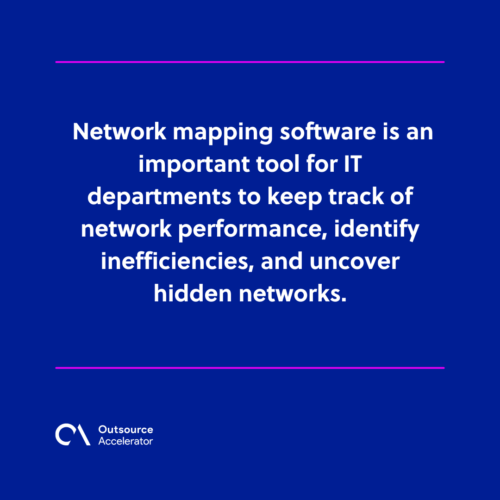Network mapping software
Definition
What is network mapping software?
Visually mapping and managing networks is made easier by network mapping software. It finds network connections and linkages for all software and hardware devices.
To acquire real-time data from linked devices, the network mapping software transmits unique data packets and protocols. The mapping system then uses the data to produce network reports.
It is an important tool for IT departments to keep track of network performance, identify inefficiencies, and uncover hidden networks.

What is network mapping?
Network mapping is the process of generating a map of a network to help users in understanding how the various components connect.
Since network mapping plays a significant role in network optimization, system performance solutions incorporate various network mapping utilities.
Network maps can be effective methods for performance monitoring. It typically includes information on whether the network is operating correctly or if any specific device is experiencing issues.
The design of your network can have a significant impact on how it operates, whether a device or server fails, and how difficult it is to administer. When you map your network, you are converting its design into a visual diagram that’s easier to interpret and analyze.

Choosing the right network mapping software
Network health and uptime are crucial components that can be monitored through network mapping.
Network maps can help you improve system performance in three ways: network visualizations, device monitoring, and network issue diagnostics.
Before choosing software, users should know all of their needs, such as the number of devices to be mapped and the various equipment they have. Users can seek a solution with remote administration and automation options based on their needs.
Why do businesses need network mapping software?
Here are reasons why businesses need network mapping software:
To monitor the network
A network mapping software helps assess network availability on a local system, whether it’s LAN or WiFi. With network monitoring functions, it records and shows information such as real-time download and upload speeds. It also helps in the prevention of network overloads.
Network bandwidth monitoring is critical for organizations since any disruption or slowdown might result in employee idling or the unexpected interruption of any crucial internet-based task.
To optimize network performance
A logical way to analyze the connection between reference sites and associated devices is network mapping. It supports the optimization of overloaded networks by providing network managers with a complete description of network improvement options.
To address compliance-related issues
Especially for large companies, their networks may be interconnected through servers and systems located in various locations.
Government and legal bodies often audit businesses to ensure that they meet global information security requirements. For this purpose, network mapping software can efficiently create reports to show compliance.
To streamline procedures and save time
Even for experts, network diagrams are tough to build manually and regularly update. IT administrators may use network mapping software to efficiently visualize the network and update any changes instantly.
Further, IT teams may save time for the entire company by decreasing delays.
To better understand network visualization
Network maps divide large networks into smaller, well-defined components. It enables network managers to understand every part of a network, no matter how complex.
If there is a network disruption, this makes it simple for IT managers to conduct a root-cause investigation of the problem.







 Independent
Independent




